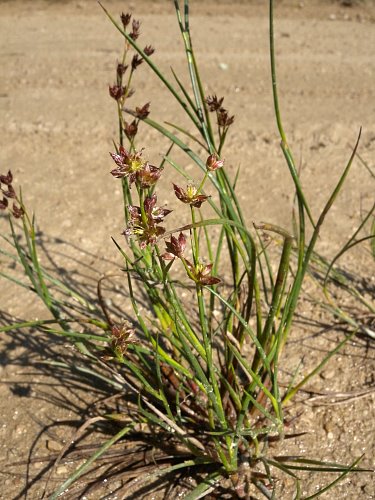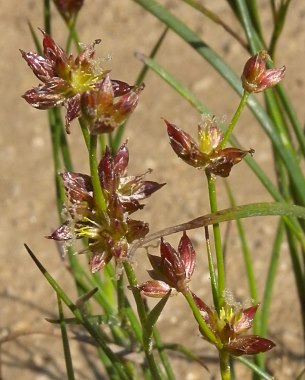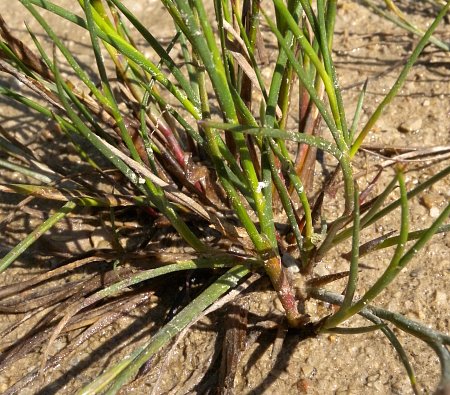
The blooming period occurs during mid- to late summer for about 2-3 weeks for a colony of plants. The flowers are cross-pollinated by the wind. Shortly afterwards, the seed capsules develop, becoming reddish brown to dark brown at maturity. The seed capsules are 3-4 mm. long, ellipsoid, and 3-angled in shape; they have short beaks at their apices that are relatively conspicuous. Eventually, individual seed capsules divide into 3 parts, releasing their tiny seeds. These seeds are up to 0.5 mm. in length, pale brown, ellipsoid, and somewhat flattened in shape; their tips usually have tiny appendages, but they are not winged. The tiny seeds can be carried aloft by the wind or float to new areas on water. The root system is fibrous and rhizomatous, occasionally forming clonal offsets.
Cultivation: The preference is full sun, wet to moist conditions, and calcareous soil containing sand, clay, or a combination of the two. Occasional inundation by shallow water is tolerated. This small rush is not competitive with larger ground flora on fertile soil. It is slightly weedy.

Range & Habitat: The Jointed Rush has been found in Cook County, Illinois, where it is rare (see Distribution Map). This rush may be native to the state, or it could be adventive from outside of the state. This rush is native to some areas of Eurasia, North Africa, and North America. Habitats include margins of streams and lakes, sandy ditches, sandy swales, sandy pannes, poorly drained areas along railroads, and poorly drained areas of bicycle paths. This rush often colonizes disturbed wetlands that are relatively open and barren.
Faunal Associations: Various insects feed on rushes (Juncus spp.) in wetlands. These species include the seed bugs Cymodema breviceps and Cymus angustatus, the leafhopper Macrosteles potoria, the root-feeding aphid Prociphilus corrugatans, Livia maculipennis (Rush Psyllid), larvae of the introduced sawfly Eutomostethus luteiventris, and stem-boring larvae of two moths (Archanara subflava, Chilo forbesellus). The small size, coarse foliage, and tiny seeds of this rush limit its usefulness to vertebrate animals, although there is some evidence that the rhizomes and crowns of wetland rushes are eaten by the muskrat, while a dabbling duck, Anas crecca (Green-Winged Teal), feeds on their seedheads. The tiny seeds of Jointed Rush may be transported to new areas by the muddy feet and feathers of waterfowl, the muddy shoes of humans, and the tire treads of bikes.

Photographic Location: A poorly drained area of a bicycle path at the Indiana Dunes National Lakeshore in NW Indiana, where there was a thin layer of sand above a hard layer of gravel and clay.
Comments: This small rush to easy to overlook and it is very similar in appearance to the Northern Green Rush (Juncus alpinoarticulatus). There is some evidence that the Northern Green Rush is one of the parents of the polyploid Jointed Rush (Juncus articulatus). These two species can be distinguished by the shapes of their seed capsules: the seed capsule apices of Jointed Rush are more tapered and pointed than those of Northern Green Rush. In addition, the inner tepals of Jointed Rush have acute tips, while those of Northern Green Rush usually have blunt tips. There is a tendency for the inflorescence of Jointed Rush to be more divergent and less elongated than the inflorescence of the latter rush, but there is some overlap in the form of inflorescences between these two species.